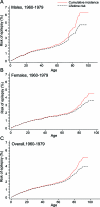Estimating risk for developing epilepsy: a population-based study in Rochester, Minnesota
- PMID: 21205691
- PMCID: PMC3032191
- DOI: 10.1212/WNL.0b013e318204a36a
Estimating risk for developing epilepsy: a population-based study in Rochester, Minnesota
Abstract
Objectives: Previous studies that have assessed the risk of developing epilepsy have failed to account for the competing risk of death, significant in the elderly where epilepsy incidence is highest. We report the lifetime risk for epilepsy, accounting for the competing risk of mortality.
Methods: Lifetime risk and cumulative incidence of epilepsy were examined among Rochester, MN, residents between 1960 and 1979. Age-, gender-, and calendar year-specific deaths were obtained for Rochester, MN. Lifetime risk was calculated as the conditional probability of developing epilepsy by a specific age for a person reaching that age who had not yet developed epilepsy. Lifetime risk and cumulative incidence were compared for age and time period.
Results: We identified 412 individuals with incident epilepsy diagnosed between January 1, 1960, and December 31, 1979. Lifetime risk was 1.6% to age 50 and 3.0% to age 80; cumulative incidence was 1.7% to age 50 and 3.4% to age 80. Similar differences were seen across epilepsy etiologies. Lifetime risk through 87 years of age increased over time from 3.5% in 1960-1969 to 4.2% in 1970-1979.
Conclusions: One in 26 people will develop epilepsy during their lifetime. Lifetime risk provides an estimate of an individual's risk for epilepsy over his or her remaining lifetime, translates into the number of people who are expected to develop epilepsy, and assists health care planners as they estimate service needs for epilepsy.
Figures

Comment in
-
"Flying blind" without epilepsy surveillance data.Neurology. 2011 Jan 4;76(1):10-1. doi: 10.1212/WNL.0b013e318203e9b0. Neurology. 2011. PMID: 21205686 No abstract available.
References
-
- Hauser WA, Annegers JF, Kurland LT. Incidence of epilepsy, unprovoked seizures in Rochester, Minnesota: 1935–1984. Epilepsia 1993;34:453–468 - PubMed
-
- Gaynor JJ, Feuer EJ, Tan CC, et al. On the use of cause-specific failure and conditional failure probabilities: examples from clinical oncology data. J Am Stat Assoc 1993;88:400–409
-
- Seshadri S, Wolf PA. Lifetime risk of stroke and dementia: current concepts, and estimates from the Framingham Study. Lancet Neurol 2007;6:1106–1114 - PubMed
-
- Commission on Classification and Terminology of the International League Against Epilepsy Guidelines for epidemiological studies on epilepsy. Epilepsia 1993;34:592–596 - PubMed
-
- US Department of Health, Education, and Welfare Public Health Service 950 Minnesota State Life Tables 1949–1951, vital statistics. Special Reports 1956;41(suppl 22).
